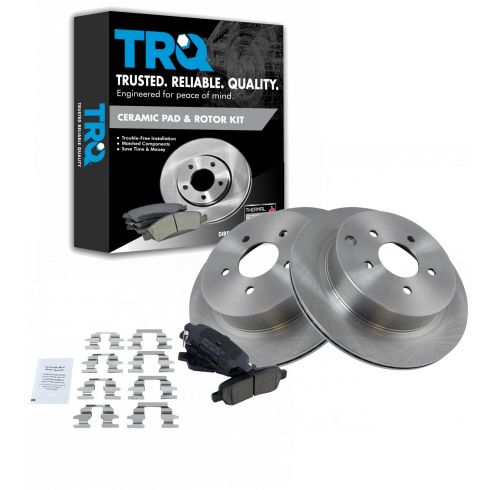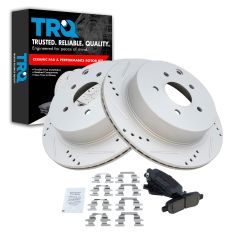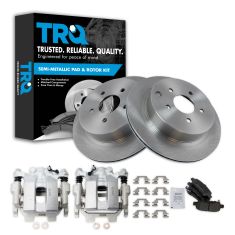1ABFS00465-Nissan Infiniti Rear Ceramic Brake Pad & Rotor Kit TRQ BKA10688

Replaces
2013 Infiniti M35h Rear Ceramic Brake Pad & Rotor Kit TRQ BKA10688

Product Reviews
Loading reviews
4.48/ 5.0
27
27 reviews
excellent experience
January 22, 2018
purchased brake kit for my vehicle, it arrived in two days, and the mechanic at the dealer installed with no objections, signifying the quality of the parts.
Fits great
September 26, 2019
Perfect fit for the rear brakes of my 05 Murano
2012 nissan quest
March 31, 2020
Fast shipping and parts fit great!! Very good company and will keep buying parts here.
Excellent service!
August 5, 2020
Quality of the products I purchased from you guys or delivered on time and cost efficient! Its what everybody wants and expects in society today.Keep doing what youre doing and dont stop striving for perfection!
October 3, 2020
Good product
Recommend to everyone to buy from
April 17, 2021
I have bought parts from here before and I highly recommend to everyone just how they use at a price that's affordable and parts that are reliable and factory fit parts will buy in future again
Beautiful brakes
May 16, 2021
Every thing came in a timely matter and all contents was included the brakes look beautiful
Great Value
August 30, 2021
Great kit. Came with slide clips and caliper grease too, which in my experience usually only come with the premium pads. Wish the caliper hats were painted, but great kit for the money. Will buy again.
Rust easily
October 18, 2021
If you don't like seeing rusty rotors, stay away from these. Otherwise they fit well and perform their job well.
February 3, 2022
All fits
No complaints
February 5, 2022
Quality parts at a great price. Everything I needed to complete the job. Im glad my buddy told me about this website.
March 1, 2022
Yes very pleased good quality very happy good price also
January 19, 2023
For a tight budget they will stop your car. But they are not quiet by any means. I would not recommend getting these unless you really need them.
April 16, 2023
Great. Stops well!
June 8, 2023
Parts came quick and were correct parts
Great product delivered to your door.
July 4, 2023
Excellent product. Perfect fit.
Good product, inspect when received.
September 27, 2023
Easy ordering, fast shipping and delivery. One rear rotor had a very deep gouge in it making it unusable. Unfortunately I already had one side of the rear break system off when I discovered this so be sure to inspect all parts before you begin. I called Monday and they no questions asked shipped a new rotor out. Had it on that Friday and breaks are good to go.
November 10, 2023
Perfect fit although pads not very good
November 27, 2023
Everything fit, they everything I need for my vehicle
Rear brake pads and rotors.
December 24, 2023
Appear to be quality parts and your amazing tutorial videos made the job reasonably easy. I did have to file ever so slightly the ends of the pads so they could slide in the stainless races. Brakes are back to better than new. Dealership wanted $499 to do the job. Think I paid $110 for the parts and done in 3 hours, do the math!
January 5, 2024
Good parts and service
January 9, 2024
I have to replace my brake pads and rotors and it's been less than a year since I bought them .
January 28, 2024
Perfect product. Many thanks
Brakes
April 20, 2024
They arrived quickly and completely. The available videos help me do things on my own.
June 9, 2024
Makes my car drive so smooth
Perfect
August 29, 2024
where do I start this was easy on the wallet materials that just fit right onto the studs spot on just right. we are completely upgraded driving around town completely safe with the kids and the dogs AND we're going on a camping trip end of october which these parts will help make sure we have a good trip.
Trabajo en casa
September 16, 2024
Muy buen producto y la entraga a tiempo Gracias
Customer Q&A
What is the inner diameter of the rotors? I just want to make sure they will fit over the parking brake shoes.
June 26, 2018
10
The actual measurements are not available however these are made to replace the OEM for the exact models listed.
June 26, 2018
Christa R
This come with two rotors?
July 24, 2022
10
Yes. It says in the description that there are (2) Rear Replacement Brake Rotors
July 24, 2022
K S
10
Yes, two brake rotors are included in this kit.
July 25, 2022
Emma F
Infiniti is a registered trademark of Nissan Motor Co., Ltd. 1A Auto is not affiliated with or sponsored by Infiniti or Nissan Motor Co., Ltd.
See all trademarks.













